In my book any critter that beats the snot out of a yellowjacket deserves more than faint praise.
Several days ago I posted a single shot of this flycatcher with the yellowjacket (along with other photos) and promised to include more of them in the future. Today I’m keeping my word. All photos are presented in the order they were taken.
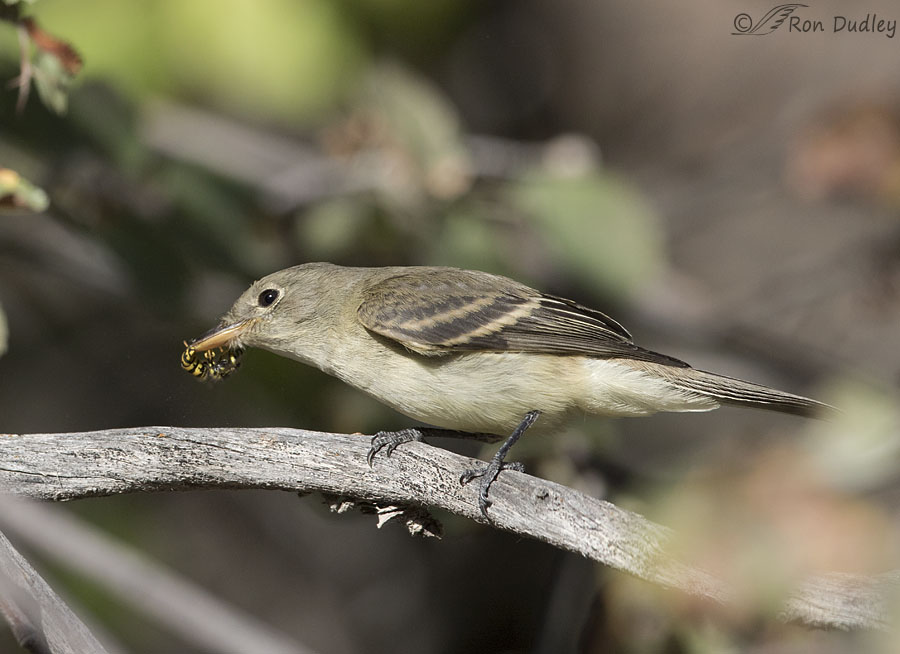
1/2500, f/6.3, ISO 800, Canon 7D Mark II, Canon EF 500mm f/4L IS II USM + EF 1.4 III Extender, not baited, set up or called in
Five days ago in the Wasatch Mountains this Dusky Flycatcher latched on to a potentially painful meal so ‘he’ was very careful to avoid getting stung. This photo was taken soon after he landed here and he’s already holding it by the stinger just to be safe.
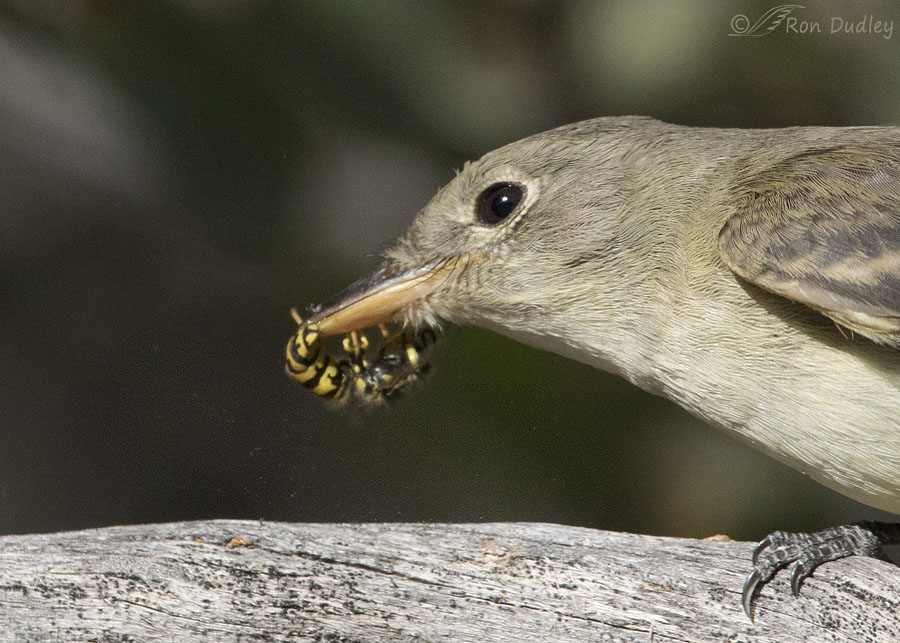
1/2500, f/6.3, ISO 800, Canon 7D Mark II, Canon EF 500mm f/4L IS II USM + EF 1.4 III Extender, not baited, set up or called in
Even though the head isn’t particularly sharp a highly cropped version of the previous image reveals two things: he’s holding it by the stinger and he’s beating up on it by slamming it into the perch, as evidenced by the many specks of presumed pollen being knocked off of the yellowjacket. You have to look carefully to see the pollen in the air but it’s there. Yellowjackets don’t use pollen in the same way many bees do but they can become covered in it during their quest for nectar.
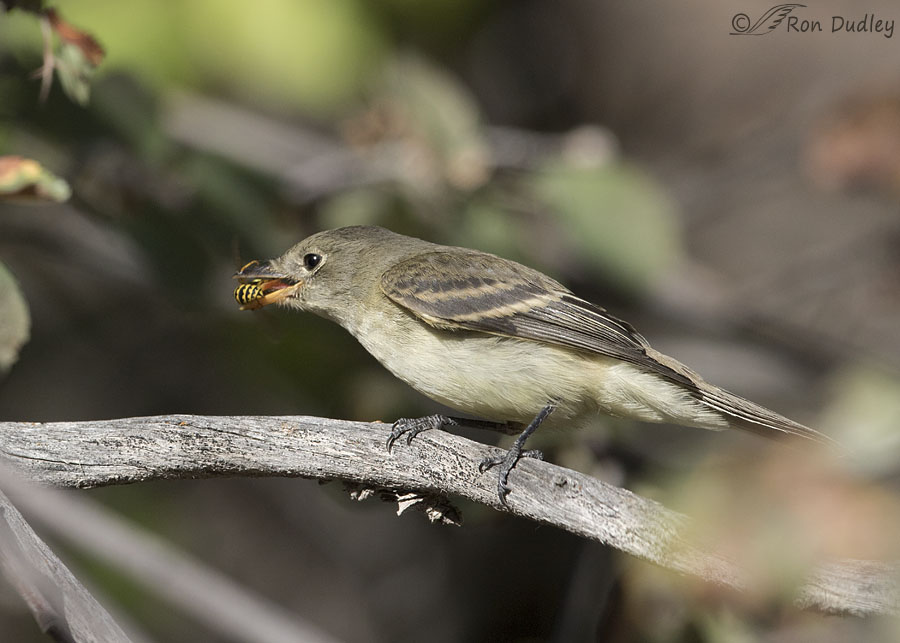
1/2500, f/6.3, ISO 800, Canon 7D Mark II, Canon EF 500mm f/4L IS II USM + EF 1.4 III Extender, not baited, set up or called in
After a few more whaps against the branch the bird seemed to ‘taste’ the insect with its tongue. I’m guessing that he was somehow checking to see if it was ‘dead enough’ for swallowing.
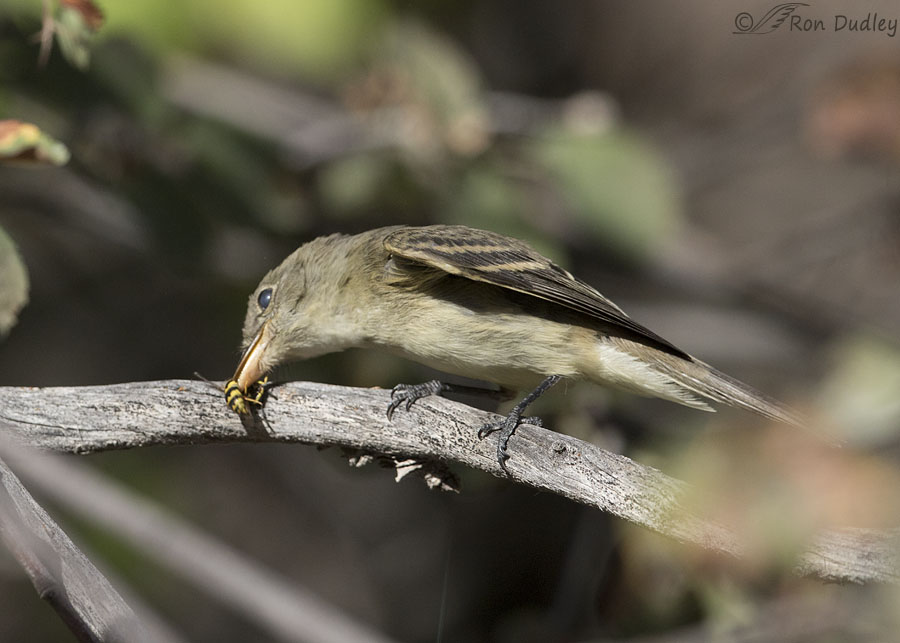
1/3200, f/6.3, ISO 800, Canon 7D Mark II, Canon EF 500mm f/4L IS II USM + EF 1.4 III Extender, not baited, set up or called in
It wasn’t. The flycatcher apparently wasn’t satisfied with the delayed expiration date of the yellowjacket so he slapped it around again for a while. The cloudy eye is caused by the closed nictitating membrane – birds close it in situations like this to protect the eye.
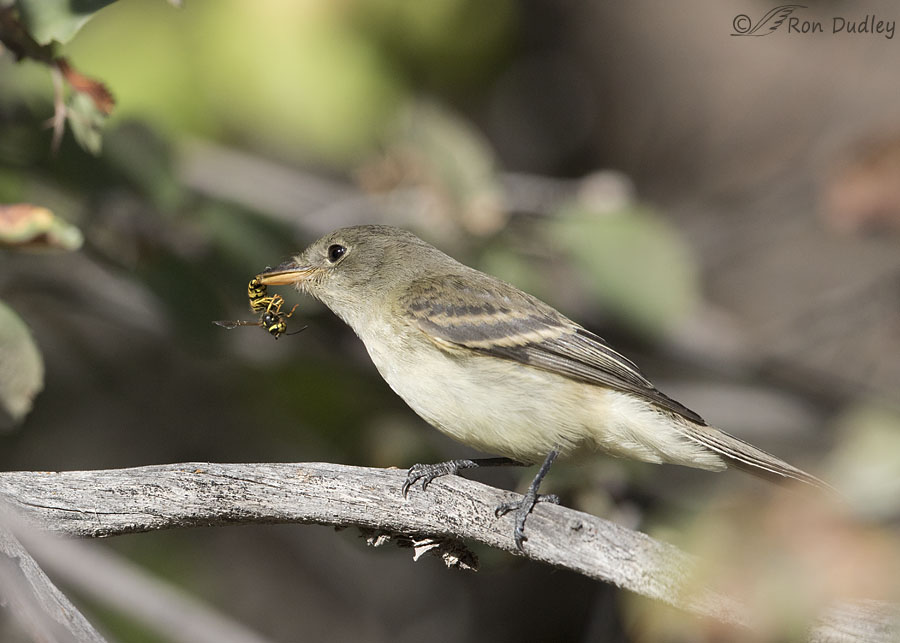
1/2000, f/6.3, ISO 800, Canon 7D Mark II, Canon EF 500mm f/4L IS II USM + EF 1.4 III Extender, not baited, set up or called in
At this point the yellowjacket looked pretty beat up, including having a flattened abdomen.
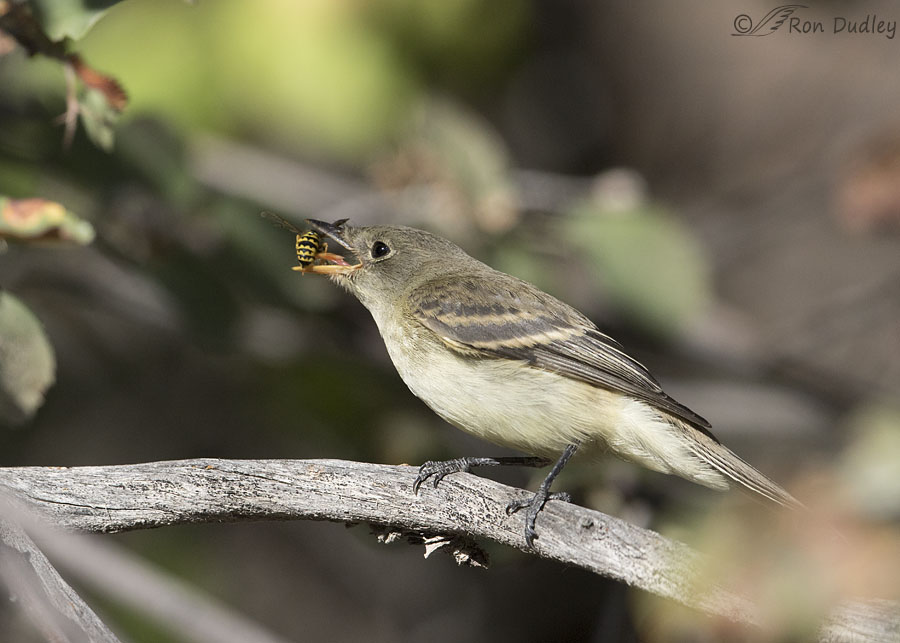
1/2500, f/6.3, ISO 800, Canon 7D Mark II, Canon EF 500mm f/4L IS II USM + EF 1.4 III Extender, not baited, set up or called in
So he tried the taste test with his tongue again.
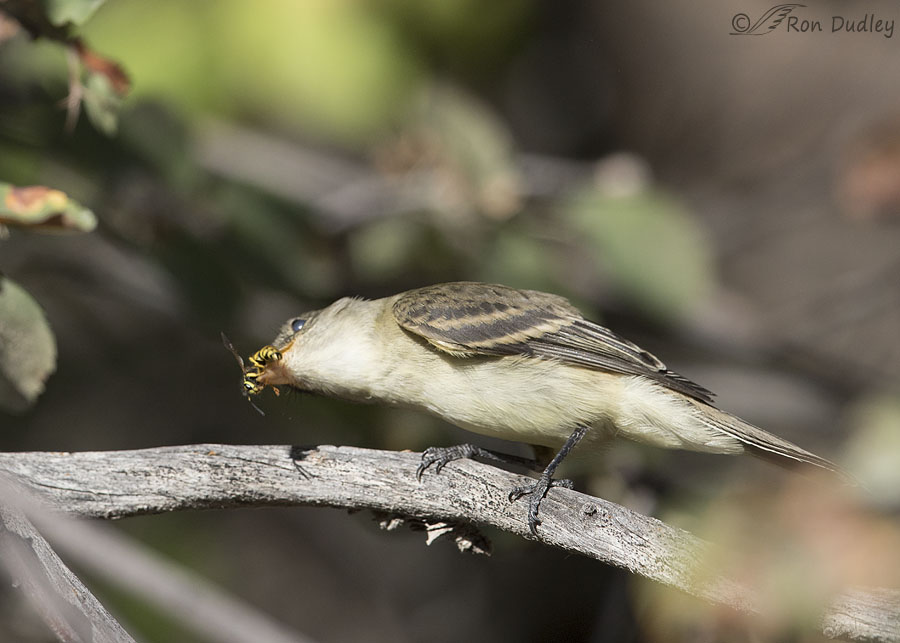
1/2000, f/6.3, ISO 800, Canon 7D Mark II, Canon EF 500mm f/4L IS II USM + EF 1.4 III Extender, not baited, set up or called in
Nope, still not dead enough so he beat up on it some more before….
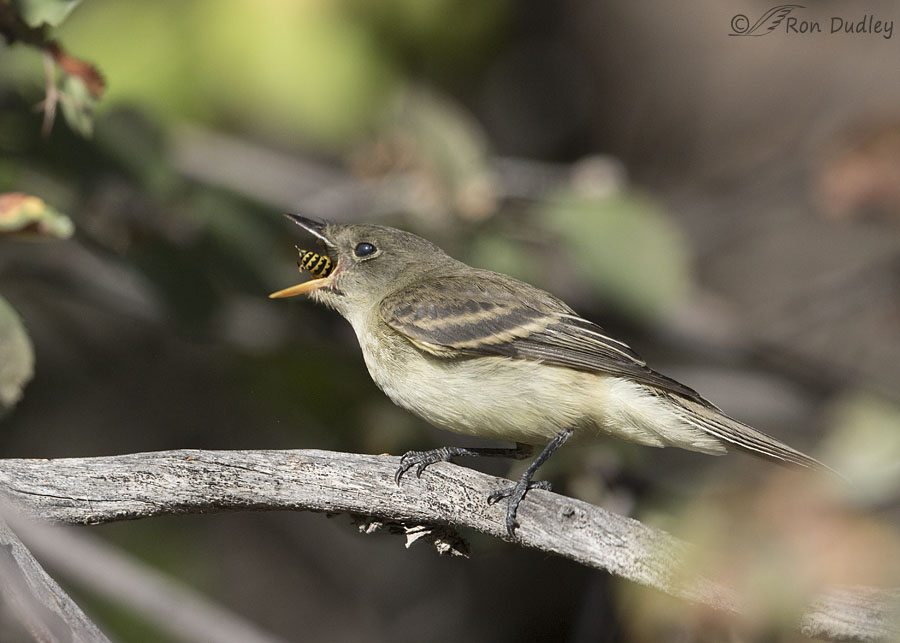
1/3200, f/6.3, ISO 800, Canon 7D Mark II, Canon EF 500mm f/4L IS II USM + EF 1.4 III Extender, not baited, set up or called in
eventually swallowing it.
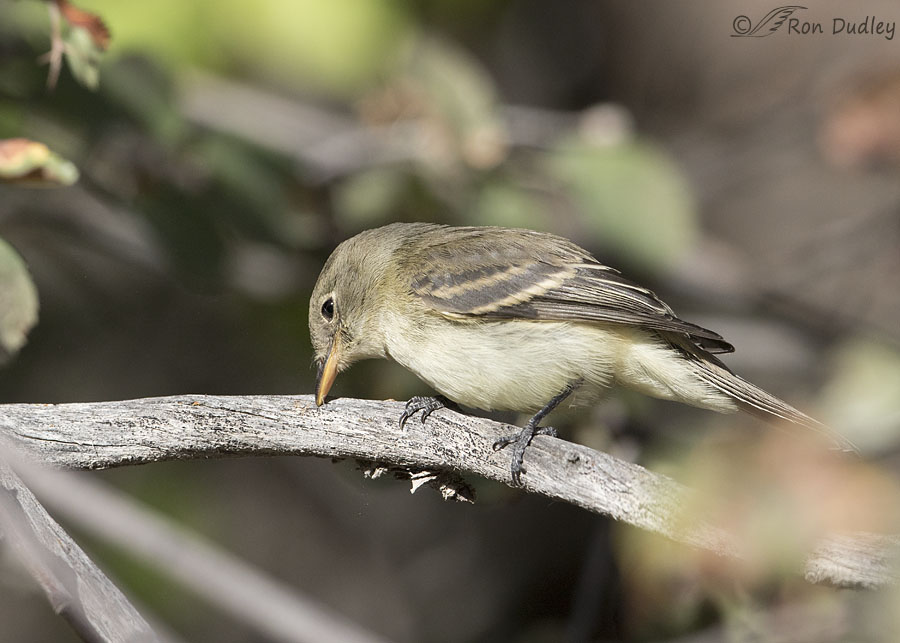
1/2000, f/6.3, ISO 800, Canon 7D Mark II, Canon EF 500mm f/4L IS II USM + EF 1.4 III Extender, not baited, set up or called in
The meal was followed by an inevitable bill-cleaning. I wasn’t happy with the out-of-focus vegetation in front of the tip of the bird’s tail in this series but at least the action was clearly visible.
And another yellowjacket bites the dust. No sleep lost here.
Ron
Note: When I noticed that the second to the last photo looked reasonably sharp I wondered if a huge crop would allow us to see the yellowjacket’s stinger.
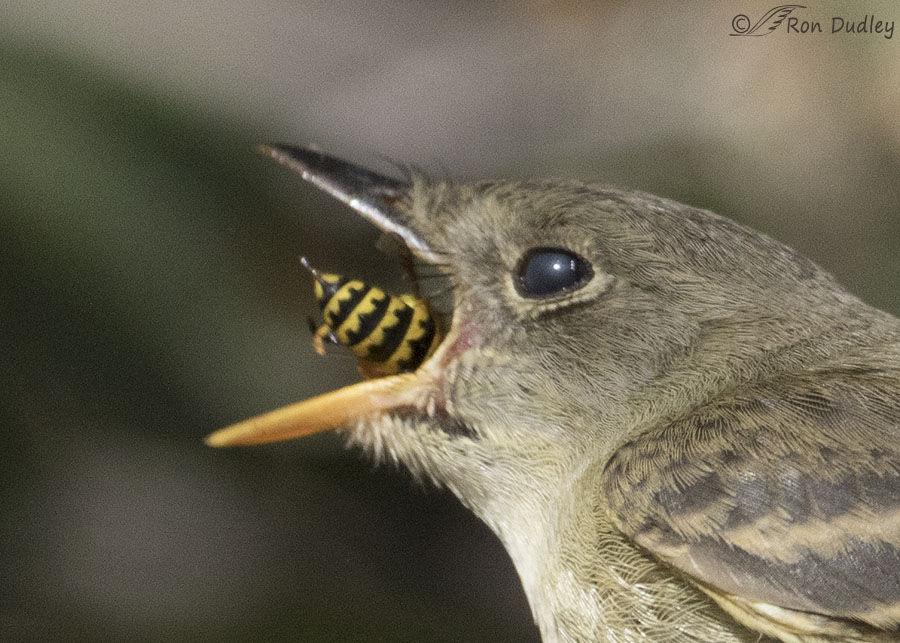
Yes, I believe we can see it here, even though this version has been cropped to only 5% of the original photo. Sometimes modern, high-quality optics amaze me and this bird’s head wasn’t perfectly sharp to begin with.
At first I thought that what we see is too long to be the stinger (especially compared to the shorter stinger of a honeybee) but when I looked up “yellowjacket stinger” using Google Image Search it appears that yellowjackets have stingers that are easily this long. Any thoughts – stinger or something else, perhaps a leg? I lean towards stinger
Another observation. Here we can see how the rictal bristles in front of the mouth might be helpful in funneling food down the throat.


Ron, was the habitat conducive of that of a Willow Flycatcher? That bill looks too large and concave on the edges along with the entirely pale lower mandible to be a Dusky. As you know, these empidonax flycatchers can be a real challenge to identify to species. But hey, that’s what makes it fun!
The habitat was more appropriate for Dusky than Willow but I’ve (apparently) seen both in that canyon.
Ok Ron, we’ll leave it at that. Looking forward to more of your amazing work in the future.
Marty, I just don’t know enough about flycatcher ID to know for sure one way or another.
Well I’m certainly no expert. I just enjoy the opportunity to view photographs like yours that give us the opportunity to have these conversations. It makes us all better birders.
Ron, I’m curious as to how you determined this was a Dusky Flycatcher? Amazing series of shots. Love your blog.
Marty
Marty, A very bird-knowledgeable friend provided the ID for me.
Great series! That bird beats them almost as much as I do. Fascinating how he knew how to grab it in the right spot and how much it had to be ‘beat up’…and the tongue checking! I wonder if it was a slight vibration he was feeling for…what ever it was, it was ingenious! Yellowjackets are probably my most hated ‘stinger’. A few summers ago I was watering a garden bed and must have sprayed an inground nest; before I knew it I had a few dozen on my arm and hand…never knew I could swat and run that fast! Very interesting note on the bristles…always something interesting to learn here.
Having been on the receiving end more than once, I’d say it’s the stinger. These are fabulous shots! Fascinating!
Thanks, Marty. I’m pretty sure it is.
Kind of feel sorry for the poor Wasp though…Good series of a snack Ron!
Thanks, Jean. Not me.
Yellowjackets have a role in nature, just like all critters. Their main role is that of recyclers, or eaters of dead animals and decaying vegetation like fallen fruit. Their larvae and adults are a food source, as you have shown, for birds and animals like raccoons. If you ever douse a ground nest of yellowjackets with pyrethrins, the local raccoons and skunks will dig it up and eat the larvae. So, much as we hate those tormenting guys, they have a role, like all creatures that have evolved to live in our world.
Great series of photos, Ron!
I’m fully aware they have a role, Susan. I still don’t like them.
Great series Ron! Really fantastic sequence.
It only feels right to get one back on those yellow jackets.
I had a painful and swollen encounter as a youngster involving sliding down a hill on cardboard and crashing into a maple tree with a yellow jacket nest at the base.
Over fifty stings apiece for both my brother and I, so yes, beating, crushing and consumption seems fitting and I thank the flycatcher for delivering the justice.
Wow, that could have been very serious for both you and your brother, Dave. Glad you’re still with us…
If my food had such vicious stingers I would beat the snot out of it too. Again and again and again. Not a lesson that the bird (or I) would need repeated either. (That said, I have burnt my mouth more than once because I wasn’t prepared to wait till it cooled. Queen of the slow learners.)
I’m notorious for burning my mouth on hot food, EC – pizza in particular.
I was thinking pizza as I read EC’s comment. I still don’t learn — totally singed my mouth this past weekend…
A very fascinating series of photos. Yellowjackets are just plain mean and oh, do the stings hurt. I can’t think of a single positive thing about them.
Thank you, Ron
Agreed, Alice. Thank you.
If I had to work this hard for a meal, I’m sure I’d starve to death! These are terrific images, Ron, and they give me a much greater appreciation for how difficult a wild bird’s life must be. Why I will always “supplement” with the feeders in my backyard (which isn’t nearly so wild nor does it have yellowjackets, but still…).
You’re lucky to not have yellowjackets in your yard, Chris. Very lucky…
Definitely stinger – they are actually longer than that when the wasp extends them to attack.
First time I ever saw a Summer Tanager it was doing exactly the same thing, repeatedly. It had found a nest and was just grabbing them one after another. Love at first sight!
Just found out at an Audubon talk last night that the rectal bristles have nothing to do with catching or handling insects – many non-insectivores also have them – they are actually air-motion-sensors that relay information to the bird’s flight system. Somewhat like the way whiskers work in some mammals.
Interesting about the bristles, Tim. I didn’t know that.
Wonderful series. I’ve taken photos of Steller’s Jays doing much the same. I would suggest that the bird is using the tongue for tactile sensation. Most birds do not have taste receptors on their tongues. Rather, taste buds are in the roof of the mouth and the back of the oral cavity. Thee tongue does have some touch receptors.
Thanks, Dan. I agree about what it was doing with the tongue.
That’s one very particular flycatcher! Excellent series, Ron. I, too, am in favor of anything that reduces the yellow jacket population.
Yellowjackets making good bird food is about the only positive thing I can think of about them, Robyn…
Awesome series Ron! To each his own when it comes to diet :>)).
Charlotte
Thanks, Charlotte.
Definitely a stinger. I love that you were able to catch this series. And for me, even in the large crops, the head is sharp enough. I wish my not so sharp shots were this good!
Thank you, Susan.
Ron, I swear-in more ways than one- it seems that this stinger may not be long enough. For the pain inflicted seems to indicate a much longer stinger.
I tried to photograph Steller’s Jays doing the same here in Oregon a few weeks ago. Just to many dark shadows. The steller’s did not beat the crap out the hornets. Just one squeeze and a swallow. At the same time I tried to photo the Red-breasted Nuthatches in their catching and eating some Bald-faced Hornet. Just way to fast.
jake
Ha, good point about the stinger, Jake.
Outstanding series Ron. That poor yellowjacket got smashed and beaten to death before he became a meal for the Flycatcher. Wonder if Flycatchers are hatched already having the knowledge of how to do this? Great photos Ron.
Everett Sanborn, Prescott AZ
Everett, I’m betting they learn it at least partly from experience. Being stung on the tongue would certainly help one to remember…
Yup, believe also it is the stinger!!
A very interesting post and wonderful series of shots.
Love the fact that we have proof that birds actually do feed on Yellowjackets! Absolutely terrific!
I’ve observed and photographed several other species that feed on them too, Dick.
VERY IMPRESSIVE food preparation skills……..thanks for this really interesting series ! I’d previously only known of cats playing with ( “beating the snot out of ” ) their
food to make sure that it was good and dead….
Kingfishers are notorious for doing it too, Kris.
Excellent series of shots & explanation of animal behavior. Thanks again.
Thank you, Elmer.
Interesting! Definitely not the birds “1st rodeo” with yellowjackets! I try not to get close enough to observe the stingers so no thoughts on it’s length. Know what they can do particularly when a dog chases one up my pant leg!..
I try not to get close enough to observe the stingers so no thoughts on it’s length. Know what they can do particularly when a dog chases one up my pant leg!..  Dog may like it’s “Jalapena Sky Raisins” – I don’t! It does appear the bristles might help moved it down the line.
Dog may like it’s “Jalapena Sky Raisins” – I don’t! It does appear the bristles might help moved it down the line.
“Know what they can do particularly when a dog chases one up my pant leg”
I’ll bet you know how to dance, Judy!
Yes, I’ve had dogs who seem to absolutely hate yellowjackets and will gleefully kill them at every opportunity.
How to get pantless VERY fast!